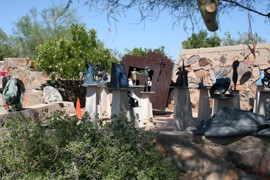Cronkite News has moved to a new home at cronkitenews.azpbs.org. Use this site to search archives from 2011 to May 2015. You can search the new site for current stories.
Taliesin West archives to be moved to New York City
SCOTTSDALE – Nestled in the foothills of the McDowell Mountains, Taliesin West, winter home of the modernist architect Frank Lloyd Wright, has housed thousands of archived sketches, models, manuscripts and personal belongings since his death in 1959.
Soon, however, the Frank Lloyd Wright Foundation will be moving these items to homes in New York City with a stated goal of ensuring their long-term survival and accessibility to researchers.
And with these items will go not just a collection of national importance but a piece of Arizona’s cultural heritage, said Paul Zygas, an associate professor of architecture at Arizona State University.
“I have no idea why would Taliesin be doing it,” Zygas said. “Why are they giving away their crown jewels?”
After two years of deliberation by the Frank Lloyd Wright Foundation’s Board of Trustees, the collection of Wright’s archived work at Taliesin in Spring Green, Wis., and Taliesin West will be brought together at Columbia University’s Avery Architectural and Fine Arts Library and the Museum of Modern Art.
“What we were deciding was what provides the best opportunity for the highest level of conservation, the highest level of public access and the deepest level of impact of this original work of Frank Lloyd Wright,” said Sean Malone, the foundation’s president and CEO.
While both Taliesin and Taliesin West were efficient in storing the archives, Malone said, Columbia and Avery are elite in terms of conservation, access and innovation.
“It’s taking it from very, very good and certainly sufficient for the last 50 years and probably a few more decades to best in the world and something that ensures their care and access and impact honestly in perpetuity,” he said.
The paper archives will go to Avery, and the Museum of Modern Art will house the models.
“Together we all have distinct purposes and focus but are extremely complementary to each other in our services,” said Carole Ann Fabian, Avery’s Library director. “Frank Lloyd Wright is arguably the leading architect of American architecture, and to have his complete archives as part of Avery’s archive department is complementary with what we do.”
According to Barry Bergdoll, Philip Johnson chief curator of architecture and design at the Museum of Modern Art, the archives need better storage facilities.
“As exquisite as the landscapes of the two Taliesins are, both locations are somewhat remote and therefore not as easy for scholars from around the world as New York,” Bergdoll said in an email.
Wright began building Taliesin West in 1937 as his winter home, studio and architectural campus. Today, the grounds are the main campus of the Frank Lloyd Wright School of Architecture.
Zygas, an ASU architecture professor, said that considering how much time Wright spent in Arizona and how much material he produced at Taliesin West, it seems logical to keep everything here.
“The material has been here for decades and the people at Taliesin treasure it,” he said.
Malone said that while the archives will no longer be housed at Taliesin West, the change will in no way affect a visitor’s experience because access to the items being transferred was reserved for researchers and scholars.
“When you come to Taliesin West you’re still going to experience it with all the original furnishings, with all the original art, with all of the original memorabilia,” he said. “You’re still going to be able to come to Taliesin West and have this immersion experience, this living experience of Frank Lloyd Wright’s body of work.”
Zygas said institutions like Columbia and the Museum of Modern Art may be known for conservation but that plenty of museums and libraries in the Valley could store and display the archives.
“This is what the Phoenix Art Museum is for. This is what Scottsdale museums are for. This is what the ASU Art Museum is for,” Zygas said. “Wright had kind of a love-hate relationship with New York and the big cities. I don’t think he would be very happy or delighted with this sort of decision.”










